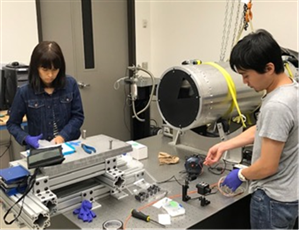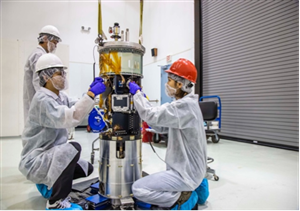- TOP
- Research
- Research Activities List
- Searching for the First Stars: Observing Cosmic Infrared Background Radiation Using NASA Rockets

Overview
An international group of researchers, whose membership includes the lab of Professor Shuji Matsuura at the Kwansei Gakuin University School of Science (Infrared Astronomy), the Kyushu Institute of Technology, Tokyo City University, and the Japan Aerospace Exploration Agency (JAXA), conducted an observation experiment using a National Aeronautics and Space Administration (NASA) rocket launched from the White Sands Missile Range (New Mexico, USA) on June 8, with the aim of clarifying early celestial objects (hereafter, objects). Named CIBER-2, the project is based on the results of CIBER (Cosmic Infrared Background ExpeRiment), an observation experiment which the group made progress on via a total of four rocket launches from 2009 to 2013. The purpose of CIBER-2 is to investigate the first stars in the universe, primordial black holes, and other early objects by observing cosmic infrared background radiation, which is a combination of infrared radiation emitted from faraway stars that cannot be captured by ground-based telescopes.
This time, the launched rocket carried a newly developed reflecting telescope, which is ten times more sensitive than what was used in the CIBER experiment. The rocket was launched to an altitude of about 300 km, where it would be unaffected by the Earth's atmosphere, and the researchers observed the cosmic background radiation for about five minutes before it fell. For CIBER-2, they observed fluctuations in multiple wavelengths, from visible light to near-infrared radiation, with a higher degree of precision that was not achieved for the CIBER experiment. In the future, the team will analyze the acquired data to search for traces of early objects.
Research Background and Development
To unravel the history of the evolution of the universe, from its inception up until the present, it is important to find early objects in the universe, and study how and when they formed and evolved into the stars and galaxies which exist today. In particular, research on the first stars and black holes *1 is one of the most important topics in astrophysics and astromony. These early objects are thought to have shone brightly in ultraviolet light. In the present, that light is expected to be observed as near-infrared light, due to the cosmological redshift*2 associated with the expansion of the universe which began with the Big Bang. The most common method for the kind of research above is to individually observe distant objects in the near-infrared. Many researchers are working on this. However, early objects are too dark to be observed individually, even with huge telescopes.
To solve this problem, the team has been conducting research using a unique method: observing cosmic infrared background radiation *3, which is a combination of light from early objects and distant galaxies. As a result of conducting observations via Japanese and U.S. satellites (COBE, IRTS, AKARI) and the CIBER experiment, the team has clearly shown that the observed cosmic infrared background radiation is not bright enough to explain the observed brightness, even if the contribution from known sources, such as galaxies, is taken into account. (Figure 1) This means that there are still objects in the universe which are unknown. Theoretical interpretations regarding the identity of these unknown objects have been announced, such as the brightness being an afterglow from the first stars in the universe or primordial black holes, and this has become a hot topic among researchers.

However, CIBER observation data suggests that most of the unknown objects are likely to be in nearby space, such as old stars hidden in galactic haloes, and that there is not much of a contribution from the early universe. For CIBER-2, using a telescope ten times more sensitive than the one used for CIBER, the team observed cosmic infrared background radiation and aimed to detect a small amount of the radiation component from the early universe.

For the experiment’s new objective, in order to boost focusing power and resolution, the team developed a 30cm reflecting telescope three times the diameter of the CIBER telescope, as well as a 4-megapixel infrared camera with a field of view double that of the CIBER camera, which was installed at the back of the telescope (Figure 2). The equipment is cooled down to -200 degrees Celsius using liquid nitrogen to prevent noise from the infrared radiation emitted by the equipment itself. Every part of the telescope is made of aluminum alloy, in order to prevent it from losing focus due to thermal contraction caused by cooling. The shape of the telescope is designed to contract in a similar way.
For CIBER-2, six photometric filters were used to separate the wavelength ranges of 0.5 to 2 μm, and the equipment took pictures of four areas in space with no bright stars at each wavelength. In addition, the equipment had spectroscopic functionality in the same wavelength ranges, and the team measured the cosmic infrared background radiation in detail. The team achieved this functionality by introducing light from one telescope into three infrared cameras, separated by wavelength, and attaching a two-wavelength filter and a spectroscopic filter to each sensor. Development of the observation equipment was shared among the countries in the international group which collaborated on the experiment. The team on the Japanese side was in charge of the development of the core components: the telescope, the optics, and the cooling system. Kwansei Gakuin University graduate and undergraduate students, not just researchers, served as the main work force for the Japanese team. They went to the American hub universities (the California Institute of Technology and Rochester Institute of Technology), led by the representatives of NASA rocket experiments, as well as to the NASA test site, to conduct various experiments until the equipment was completed (Figures 3 and 4).


Expected Results and Future Developments
CIBER-2 covers a wider range of wavelengths than CIBER did, including visible light (Figure 5). With the addition of visible light observations conducted for the first time, we will be able to clarify how much early objects contributed to the cosmic infrared background radiation, based on the Lyman-break feature *4, which is unique to early objects. After the launch, when the rocket falls, the equipment will open a parachute and land on the ground. Just the name implies, White Sands is a vast desert. If the impact from the fall is relatively minor, the instrument will be mostly undamaged, and can be reused for the next experiment. The team proposed to NASA that the CIBER-2 experiment should be done a total of four times, and that implementation was authorized. Although nothing can be said about the scientific results of this launch without a full analysis of the data, it is necessary to improve the accuracy through repetition, as each experiment only lasts for a short time. The equipment recovered by parachute will be transported to the Rochester Institute of Technology for internal verification.

The Japanese team was not able to witness the launch due to the impact of COVID-19, but hopes to visit the site in the near future to conduct verification and operation tests, as many of the devices were manufactured in Japan. If there are no major problems with the observation equipment, the plan in the future is to move forward with conducting the experiment once a year. Analysis of the observation data gained from this experiment will be divided up to some extent among the international team, and conducted concurrently.
Although the project is not at a stage where anything can be said about the possibility of detecting early objects, the team has finally been able to stand at the starting line for their goal. The hope is that CIBER-2 will continue to produce amazing scientific results in the future. Furthermore, after the CIBER-2 experiment has concluded, the team will send probes out into interplanetary space and move forward with planning for the Interplanetary Space Telescope (IPST), in order to make it possible to conduct long-term observations in a better environment than a rocket experiment. As a first step, the team is considering a plan to install infrared observation equipment, such as that developed for CIBER-2, on the transformer spacecraft and solar sail spacecraft which are being developed at the Institute of Space and Astronautical Science of JAXA. In the future, precise observations of cosmic infrared background radiation could open new doors for exploration of the early universe.
Notes
This experiment is supported by the following Grants-in-Aid for Scientific Research.
2015-2019 Grant-in-Aid for Scientific Research (S) "Probing into the Intra-Halo Light and the Epoch of Cosmic Re-Ionization by Rocket Experiments to Measure the Cosmic Infrared Background" 15H05744 (Researcher: Shuji Matsuura)
2018-2020 Fund for the Promotion of Joint International Research (Fostering Joint International Research (B)) " Observational Study of Hidden Star-Formation History through the Near-Infrared Extragalactic Background Light by the Rocket Experiment CIBER-2" 18KK0089 (Researcher: Kohji Tsumura)
Terms
1) First stars and black holes
The gravitational contraction of primordial gas in the early universe is thought to have led to the birth of the first stars. However, they are believed to have been of such enormous mass that they do not exist today, due to the high-temperature environment and gas composition at the time. Due to their high temperatures, the massive stars are thought to have shone almost exclusively in ultraviolet light. It has also been predicted that after an extremely short lifetime, those massive stars would form black holes due to gravitational collapse, which would then attract surrounding matter and shine in X-rays and ultraviolet light.
2) Cosmological redshift
Since its creation by the hot Big Bang, the tiny size of the universe has been expanding to its current gigantic size. The wavelength of light emitted in the early universe was greatly stretched as the universe expanded (stretching of space-time), and is now observed as long wavelength light. The extension of the wavelength of light is called a "redshift" because visible light turns red. Observed redshifts are larger for light emitted in the early universe.
3) Near-Infrared Extragalactic Background Light
In cosmological observation data, the brightness of areas in space where stars and galaxies are not captured is called "extragalactic background light." In the near-infrared wavelength range, the brightness from within the solar system, from within our own galaxy, and from outside the galaxy are included in this light.
4) Lyman-break feature
This phenomenon is the total absorption of ultraviolet light at wavelengths shorter than the Lyman limit (912 Å) by neutral hydrogen atoms that exist in intergalactic space. Light from distant objects passes through these atoms before reaching Earth.
Collaborating Researchers
Kwansei Gakuin University: Shuji Matsuura (principal investigator for the Japanese team), Ryo Hashimoto, Tomoya Kojima, Kohji Takimoto, Ryo Ohta, Yasuhiro Yamada, Kenta Danbayashi, Hiroko Suzuki, Masaki Furutani, Arisa Kida, Shota Sakai, Yusuke Torao, Yuya Kawano, Kazuma Noda
Kyushu Institute of Technology: Kei Sano
Tokyo City University: Kohji Tsumura
Astrobiology Center: Aoi Takahashi
JAXA Institute of Space and Aeronautical Science: Toshio Matsumoto, Takehiko Wada, Mai Shirahata, Toshiaki Arai, Yosuke Onishi
ASIAA (Taiwan): Shiang-Yu Wang
Rochester Institute of Technology: Michael Zemcov (rocket experiment lead/principal investigator for the American team), Chi Nguyen, Mikey Ortiz, Priyadarhini Bangale, Serena Tramm, Sonny Tofani, Grigory Heaton, Derek Wilson, Kevin Gates, Jodi-Ann Morgan, Drin Patru, James Parkus
California Institute of Technology: James Bock (principal investigator for the previous rocket experiment), Phil Korngut, Victor Hristov, Aricia Lanz, Lunjun Liu, Peter Mason, Richard Feder, Yun-Ting Cheng
University of California, Irvine: Asantha Cooray
Korea Astronomy and Space Science Institute (KASI): DaeHee Lee (principal investigator for the Korean team), Seung-Cheol Bang, Won-Kee Park
